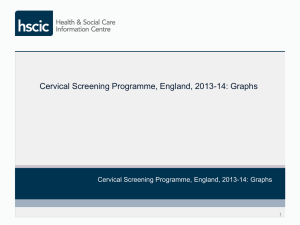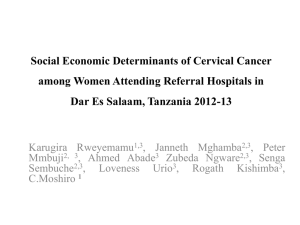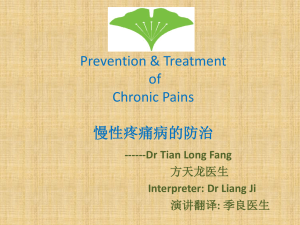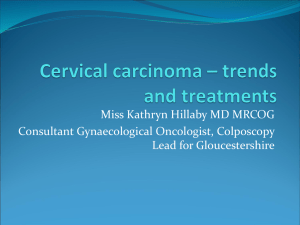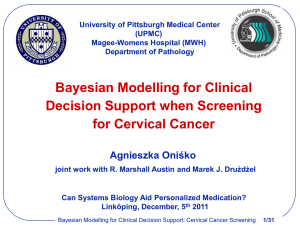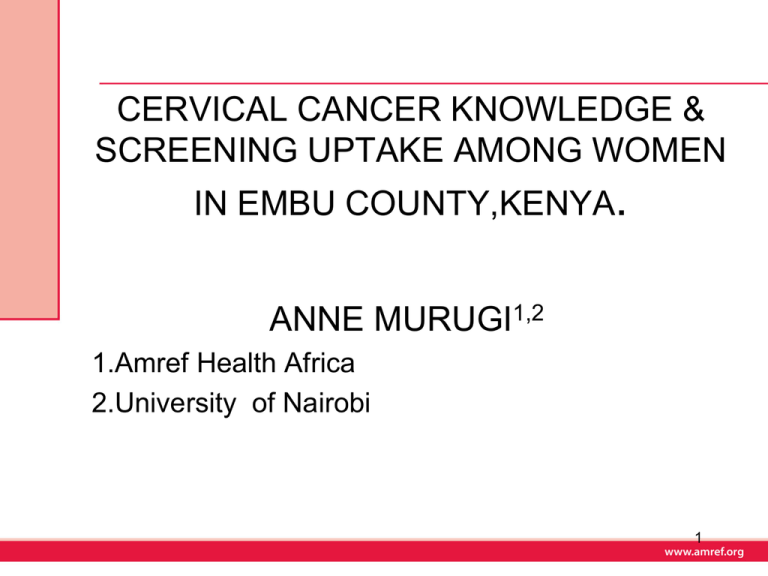
CERVICAL CANCER KNOWLEDGE &
SCREENING UPTAKE AMONG WOMEN
IN EMBU COUNTY,KENYA.
ANNE MURUGI1,2
1.Amref Health Africa
2.University of Nairobi
1
OUTLINE
•
•
•
•
•
•
Background
Objectives
Methodology
Results
Conclusion
Recommendations
2
BACKGROUND
• Cancer is the leading cause of death worldwide and
accounted for 8.2 million deaths in 2012.
• Cervical cancer. leading cause of cancer deaths among
women in developing countries.
• 529,409 new cases occurred globally, with 274,883 of the
women (52% of cases) dying.
• 86% of the cases occur in developing countries
• In SSA : magnitude of the problem is under-recognized and
under-prioritized.
• In Kenya-second most frequent cancer among women and
the leading cause of cancer deaths in women of reproductive
age.
• 2454 new cases and 1676 deaths are reported every year
• Only 3.2% of women in Kenya have been screened for
cervical cancer.
(WHO 2008,WHO2013)
3
PROBLEM STATEMENT
• Morbidity and mortality of cervical cancer can
be reduced through regular screening
• Screening is available in most facilities
(VIA/VILI) and Pap smear
• Screening levels still remain low
• Study findings will provide relevant information
to increasing uptake in rural areas
4
OBJECTIVES
• Broad objective
• To determine factors associated with cervical
cancer screening uptake among women in Embu
county, Kenya
• Specific objectives
1. To determine cervical cancer awareness &
knowledge among women in Embu
2. To determine awareness & knowledge of
cervical cancer screening
3. To determine the uptake of cervical cancer
screening
4. To determine barriers to cervical cancer
screening uptake
5
METHODOLOGY
Study design
Cross- sectional
study survey
Quantitative study
Study population
Data management
and analysis
Study site
Women aged 18 years and
above
Coding, data entry
SPSS 17
Inclusion Criteria
Frequencies
All women aged 18 and above
who gave consent
Bivariate analysis
Embu County
Sampling
Multi stage cluster
sampling
Sample size
269 women
Exclusion Criteria
Declined to consent
Ethical Considerations
Data collection
Structured Questionnaire
Ethics approval
Informed consent
Confidentiality
6
SOCIO-DEMOGRAPHICS
Characteristics
Age in years
Marital status
Education level
Employment status
Classification
<25
25-34
35-44
45-54
55-64
>64
Total
single (never married)
Married
Separated
Divorced
Widowed
Total
Primary
Secondary
Technical College
University
None
Total
Employed Fulltime
Employed part time
Unemployed
Self-employed
Full time home maker(house wife)
Retired
Others
Total
Frequency
51
102
64
33
12
7
269
58
177
20
1
13
269
123
104
30
2
10
269
34
7
46
163
15
3
1
269
Percent
19.0
37.9
23.8
12.3
4.5
2.6
100
21.6
65.8
7.4
0.4
4.8
100
45.7
38.7
11.2
0.7
3.7
100
12.6
2.6
17.1
60.6
5.6
1.1
0.4
100
CERVICAL CANCER AWARENESS
8
SIGNS AND SYMPTOMS
Knowledge of
signs of cervical
cancer
Yes
No
Don't know
Vaginal bleeding
between menses
31.6%
10.4%
58.0%
Persistent vaginal
discharge with
unpleasant smell
32.7%
10%
57.2%
Vaginal bleeding
after menopause
34.6%
3.3%
62.1%
Bleeding during or
after sex
29.0%
7.4%
63.6%
9
CERVICAL CANCER RISK FACTORS
Risk factors of
cervical cancer
Infection with HPV
Disagree
Not sure
Agree
5.6%
70.6%
23.5%
Smoking cigarettes
Weakened immune
system
Infection with STI's
14.1%
13.1%
51.7%
58.6%
34.2%
28.1%
9.3%
53.2%
37.3%
Having multiple
sexual partners
Having many
children
Having a sexual
partner with multiple
partners
Not going for regular
screening
11.6%
50.6%
37.7%
31.2%
58.7%
10.0%
13.4%
53.9%
32.7%
11.9%
52.8%
35.3%
10
CERVICAL CANCER SCREENING KNOWLEDGE
11
CERVICAL CANCER SCREENING AWARENESS
12
CERVICAL CANCER SCREENING UPTAKE
13
BARRIERS TO CERVICAL CANCER SCREENING UPTAKE
Lack of information about ca cx
77%
Long distance to the HF
26.4%
Barriers to cervical cancer screening uptake
Not offered at nearest HF
31.6%
Lack of Designated rooms
15.2%
Screening is expensive
43.9%
Lack of convinient clinic time
33.8%
Attitude of HCWs
23%
Lack of female screeners at the facility
21%
Not suggested by HCW
19%
Not allowed by culture/religion
25%
Lack of partner approval
20%
Not knowing where to go
35%
Fear of vaginal exam
60%
Not at risk
63%
Ca cx screening is painful
39%
Little undestanding of ca cx
86%
0%
10%
20%
30%
40%
50%
60%
Percentage
70%
80%
90%
14
100%
ASSOCIATIONS
Tests of association
p-value
Association between economic status
and uptake of cervical cancer screening
0.027
Association between awareness of
cervical cancer and age of respondent
0.031
Association between cervical cancer
awareness and screening uptake
<0.001
Association between awareness of
cervical cancer screening and uptake
<0.001
Association between knowledge of
prevention of cervical cancer and
screening uptake
<0.001
15
CONCLUSION
• Awareness of cervical cancer screening
among the respondents was high
• Knowledge of the signs and symptoms and
risk factors associated with cervical cancer
was low.
• Screening uptake was very low despite the
high levels of awareness of cervical cancer
and cervical cancer screening.
• Awareness of cervical cancer, awareness of
cervical cancer screening and knowledge of
modes of prevention of cervical cancer were
critical in determining cervical cancer
screening uptake among the women.
16
RECOMMENDATIONS
To the Government and County Governments
• Awareness campaigns and education
programmes to encompass signs and
symptoms, risk factors and modes of
prevention of the disease.
Research institutions
• Studies to explore the disparity between high
awareness and low uptake should be
conducted.
17
ACKNOWLEDGEMENTS
• University of Nairobi
• AMREF Kenya
• All women who participated

